Deck 13: Proteins: Structure and Function
Question
Question
Question
Question
Question
Question
Question
Question
Question
Question
Question
Question
Question
Question
Question
Question
Question
Question
Question
Question
Question
Question
Question
Question
Question
Question
Question
Question
Question
Question
Question
Question
Question
Question
Question
Question
Question
Question
Question
Question
Question
Question
Question
Question
Question
Question
Question
Question
Question
Question
Question
Question
Question
Question
Question
Question
Question
Question
Question
Question
Question
Question
Question
Question
Question
Question
Question
Question
Question
Question
Question
Question
Question
Question
Question
Question
Question
Question
Question
Question

Unlock Deck
Sign up to unlock the cards in this deck!
Unlock Deck
Unlock Deck
1/122
Play
Full screen (f)
Deck 13: Proteins: Structure and Function
1
Which of the following types of proteins provides physical support to tissues?
A) receptors
B) structural proteins
C) immunoglobulins
D) transport proteins
E) dietary proteins
A) receptors
B) structural proteins
C) immunoglobulins
D) transport proteins
E) dietary proteins
structural proteins
2
Which of the following is NOT one of the four categories of biomolecules?
A) proteins
B) vitamins
C) lipids
D) carbohydrates
E) nucleic acids
A) proteins
B) vitamins
C) lipids
D) carbohydrates
E) nucleic acids
vitamins
3
An amino acid zwitterion has
A) a net positive charge.
B) a net negative charge.
C) a net neutral charge.
D) any non-neutral charge.
E) Zwitterions can have any charge.
A) a net positive charge.
B) a net negative charge.
C) a net neutral charge.
D) any non-neutral charge.
E) Zwitterions can have any charge.
a net neutral charge.
4
In which of the following structures is the box ONLY around the amino acid side chain? 
A)a
B)b
C)c
D)d
E)e

A)a
B)b
C)c
D)d
E)e

Unlock Deck
Unlock for access to all 122 flashcards in this deck.
Unlock Deck
k this deck
5
Physiological pH is a pH of approximately
A) 5.7.
B) 7.3.
C) 8.1.
D) 9.1.
E) 0.
A) 5.7.
B) 7.3.
C) 8.1.
D) 9.1.
E) 0.

Unlock Deck
Unlock for access to all 122 flashcards in this deck.
Unlock Deck
k this deck
6
Which type of protein signals cellular events?
A) receptors
B) structural proteins
C) immunoglobulins
D) transport proteins
E) dietary proteins
A) receptors
B) structural proteins
C) immunoglobulins
D) transport proteins
E) dietary proteins

Unlock Deck
Unlock for access to all 122 flashcards in this deck.
Unlock Deck
k this deck
7
What percentage of amino acids in sickle cell hemoglobin is different from normal hemoglobin?
A) 100%
B) 50%
C) 25%
D) 10%
E) <1%
A) 100%
B) 50%
C) 25%
D) 10%
E) <1%

Unlock Deck
Unlock for access to all 122 flashcards in this deck.
Unlock Deck
k this deck
8
Which of the following structures illustrates how an amino acid reacts in a low pH solution?
A)
B)
C)
D)
E)All of these reactions occur to the same extent in a solution with a pH less than 7 .
A)

B)

C)

D)

E)All of these reactions occur to the same extent in a solution with a pH less than 7 .

Unlock Deck
Unlock for access to all 122 flashcards in this deck.
Unlock Deck
k this deck
9
Which of the following choices are the best labels for this amino acid? 
A)a
B)b
C)c
D)d
E)e

A)a
B)b
C)c
D)d
E)e

Unlock Deck
Unlock for access to all 122 flashcards in this deck.
Unlock Deck
k this deck
10
How many naturally occurring amino acids are there?
A) 1
B) 5
C) 10
D) 20
E) hundreds
A) 1
B) 5
C) 10
D) 20
E) hundreds

Unlock Deck
Unlock for access to all 122 flashcards in this deck.
Unlock Deck
k this deck
11
Which of the following choices is NOT a problem associated with sickle-cell anemia?
A) People with sickle-cell anemia are prone to severe headaches.
B) People with sickle-cell anemia are prone to episodes of infection.
C) Organs can be damaged because of sickled red blood cells.
D) Sickle-cell anemia can cause anemia.
E) The sickle cells can aggregate and clog blood vessels.
A) People with sickle-cell anemia are prone to severe headaches.
B) People with sickle-cell anemia are prone to episodes of infection.
C) Organs can be damaged because of sickled red blood cells.
D) Sickle-cell anemia can cause anemia.
E) The sickle cells can aggregate and clog blood vessels.

Unlock Deck
Unlock for access to all 122 flashcards in this deck.
Unlock Deck
k this deck
12
At low pH, the amino acid zwitterion reacts with hydronium (H3O+). What is the product of this acid-base reaction? 
A)a
B)b
C)c
D)d
E)e

A)a
B)b
C)c
D)d
E)e

Unlock Deck
Unlock for access to all 122 flashcards in this deck.
Unlock Deck
k this deck
13
Which of the following structures illustrates an amino acid at physiological pH? 
A)a
B)b
C)c
D)d
E)e

A)a
B)b
C)c
D)d
E)e

Unlock Deck
Unlock for access to all 122 flashcards in this deck.
Unlock Deck
k this deck
14
Hemoglobin is an example of this type of protein.
A) receptors
B) structural proteins
C) immunoglobulins
D) transport proteins
E) dietary proteins
A) receptors
B) structural proteins
C) immunoglobulins
D) transport proteins
E) dietary proteins

Unlock Deck
Unlock for access to all 122 flashcards in this deck.
Unlock Deck
k this deck
15
Which of the following structures illustrates an amino acid in a solution with a high pH? 
A)a
B)b
C)c
D)d
E)e

A)a
B)b
C)c
D)d
E)e

Unlock Deck
Unlock for access to all 122 flashcards in this deck.
Unlock Deck
k this deck
16
Which of the following structures illustrates an amino acid as a zwitterion? 
A)a
B)b
C)c
D)d
E)e

A)a
B)b
C)c
D)d
E)e

Unlock Deck
Unlock for access to all 122 flashcards in this deck.
Unlock Deck
k this deck
17
Which type of protein can be used for energy when necessary?
A) receptors
B) structural proteins
C) immunoglobulins
D) transport proteins
E) dietary proteins
A) receptors
B) structural proteins
C) immunoglobulins
D) transport proteins
E) dietary proteins

Unlock Deck
Unlock for access to all 122 flashcards in this deck.
Unlock Deck
k this deck
18
Which of the following biomolecules has the most diverse functions in the body?
A) carbohydrates
B) proteins
C) nucleic acids
D) lipids
E) These have equally diverse functions.
A) carbohydrates
B) proteins
C) nucleic acids
D) lipids
E) These have equally diverse functions.

Unlock Deck
Unlock for access to all 122 flashcards in this deck.
Unlock Deck
k this deck
19
Sickle-cell anemia is caused by
A) an abnormal form of acetylcholine.
B) an abnormal form of iron.
C) too little iron.
D) an abnormal form of hemoglobin.
E) Actually, the cause of this disease is unknown.
A) an abnormal form of acetylcholine.
B) an abnormal form of iron.
C) too little iron.
D) an abnormal form of hemoglobin.
E) Actually, the cause of this disease is unknown.

Unlock Deck
Unlock for access to all 122 flashcards in this deck.
Unlock Deck
k this deck
20
Which of the following types of proteins defend the body against infectious agents?
A) receptors
B) structural proteins
C) immunoglobulins
D) transport proteins
E) dietary proteins
A) receptors
B) structural proteins
C) immunoglobulins
D) transport proteins
E) dietary proteins

Unlock Deck
Unlock for access to all 122 flashcards in this deck.
Unlock Deck
k this deck
21
The following amino acid is classified as polar neutral. Which of the following statements best describes why it is classified this way? 
A) II only
B) III an IV
C) I and IV
D) I and II
E) III only

A) II only
B) III an IV
C) I and IV
D) I and II
E) III only

Unlock Deck
Unlock for access to all 122 flashcards in this deck.
Unlock Deck
k this deck
22
Which of the following is a complete protein?
A) meat
B) milk
C) eggs
D) soy
E) All of these are complete proteins.
A) meat
B) milk
C) eggs
D) soy
E) All of these are complete proteins.

Unlock Deck
Unlock for access to all 122 flashcards in this deck.
Unlock Deck
k this deck
23
The carbon with the asterisk next to it is called the 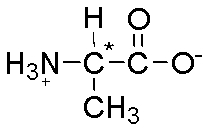
A) anomeric carbon.
B) alpha carbon.
C) beta carbon.
D) gamma carbon.
E) side chain carbon.

A) anomeric carbon.
B) alpha carbon.
C) beta carbon.
D) gamma carbon.
E) side chain carbon.

Unlock Deck
Unlock for access to all 122 flashcards in this deck.
Unlock Deck
k this deck
24
The following table lists several common vegetarian foods and the amino acids that they are missing. Which of the following combinations supply a complete protein when consumed together? 
A) wheat and corn
B) corn and beans
C) beans and peas
D) peas and corn
E) beans and walnuts

A) wheat and corn
B) corn and beans
C) beans and peas
D) peas and corn
E) beans and walnuts

Unlock Deck
Unlock for access to all 122 flashcards in this deck.
Unlock Deck
k this deck
25
At physiological pH, most carboxylic acids exist in their conjugate base form. Which of the following structures illustrates the conjugate base of a carboxylic acid?
A) HCOOH
B) CH3COO+
C) HCOO+
D) HCOO -
E) CH3COOH2+
A) HCOOH
B) CH3COO+
C) HCOO+
D) HCOO -
E) CH3COOH2+

Unlock Deck
Unlock for access to all 122 flashcards in this deck.
Unlock Deck
k this deck
26
How is the following amino acid classified? 
A) nonpolar
B) polar neutral
C) polar acidic
D) polar basic
E) None of the above

A) nonpolar
B) polar neutral
C) polar acidic
D) polar basic
E) None of the above

Unlock Deck
Unlock for access to all 122 flashcards in this deck.
Unlock Deck
k this deck
27
What is the relationship between the following two molecules? 
A) They are enantiomers.
B) They are identical.
C) They are conformers.
D) They are constitutional isomers.
E) They are unrelated.

A) They are enantiomers.
B) They are identical.
C) They are conformers.
D) They are constitutional isomers.
E) They are unrelated.

Unlock Deck
Unlock for access to all 122 flashcards in this deck.
Unlock Deck
k this deck
28
The carbon with a smiley face over it is a(n) 
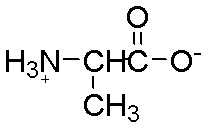
A) beta carbon.
B) anomeric carbon.
C) center of chirality.
D) secondary amine.
E) peptide bond.


A) beta carbon.
B) anomeric carbon.
C) center of chirality.
D) secondary amine.
E) peptide bond.

Unlock Deck
Unlock for access to all 122 flashcards in this deck.
Unlock Deck
k this deck
29
The following amino acid is classified as nonpolar. Which of the following statements best describes why it is classified this way? 
A) It does not form a zwitterion.
B) It is neutral at physiological pH.
C) Its side chain is not charged at physiological pH.
D) Its side chain contains only an alkyl group.
E) This amino acid is soluble only in nonpolar solvents.

A) It does not form a zwitterion.
B) It is neutral at physiological pH.
C) Its side chain is not charged at physiological pH.
D) Its side chain contains only an alkyl group.
E) This amino acid is soluble only in nonpolar solvents.

Unlock Deck
Unlock for access to all 122 flashcards in this deck.
Unlock Deck
k this deck
30
How is the following amino acid classified? 
A) nonpolar
B) polar neutral
C) polar acidic
D) polar basic
E) None of the above

A) nonpolar
B) polar neutral
C) polar acidic
D) polar basic
E) None of the above

Unlock Deck
Unlock for access to all 122 flashcards in this deck.
Unlock Deck
k this deck
31
Aspartic acid has a side chain that contains a carboxylic acid. At physiological pH, what do you expect the structure of aspartic acid to look like? 
A)a
B)b
C)c
D)d
E)e

A)a
B)b
C)c
D)d
E)e

Unlock Deck
Unlock for access to all 122 flashcards in this deck.
Unlock Deck
k this deck
32
Which of the following amino acids is polar neutral? 
A)a
B)b
C)c
D)d
E)e

A)a
B)b
C)c
D)d
E)e

Unlock Deck
Unlock for access to all 122 flashcards in this deck.
Unlock Deck
k this deck
33
What is the relationship between the following two molecules?
A) They are enantiomers.
They are enantiomers.
B) They are identical.
C) They are conformers.
D) They are constitutional isomers.
E) They are unrelated.
A)
 They are enantiomers.
They are enantiomers.B) They are identical.
C) They are conformers.
D) They are constitutional isomers.
E) They are unrelated.

Unlock Deck
Unlock for access to all 122 flashcards in this deck.
Unlock Deck
k this deck
34
Which of the amino acids does NOT contain a chiral carbon? 
A)a
B)b
C)c
D)d
E)e

A)a
B)b
C)c
D)d
E)e

Unlock Deck
Unlock for access to all 122 flashcards in this deck.
Unlock Deck
k this deck
35
How is the following amino acid classified? 
A) nonpolar
B) polar neutral
C) polar acidic
D) polar basic
E) None of the above

A) nonpolar
B) polar neutral
C) polar acidic
D) polar basic
E) None of the above

Unlock Deck
Unlock for access to all 122 flashcards in this deck.
Unlock Deck
k this deck
36
What is the charge on lysine, a basic amino acid, at physiological pH?
A) "+2"
B) "+1"
C) "0"
D) "-1"
E) "-2"
A) "+2"
B) "+1"
C) "0"
D) "-1"
E) "-2"

Unlock Deck
Unlock for access to all 122 flashcards in this deck.
Unlock Deck
k this deck
37
Which of the following amino acids contain a thiol?
A) tyrosine
B) histidine
C) threonone
D) cysteine
E) serine
A) tyrosine
B) histidine
C) threonone
D) cysteine
E) serine

Unlock Deck
Unlock for access to all 122 flashcards in this deck.
Unlock Deck
k this deck
38
Which of the following statements best defines an essential amino acid?
A) It is an amino acid that is necessary for life.
B) It is an amino acid that is synthesized in the body.
C) It is any of the 20 amino acids.
D) It is another name for the nonpolar amino acids.
E) It is an amino acid that cannot be produced by the body.
A) It is an amino acid that is necessary for life.
B) It is an amino acid that is synthesized in the body.
C) It is any of the 20 amino acids.
D) It is another name for the nonpolar amino acids.
E) It is an amino acid that cannot be produced by the body.

Unlock Deck
Unlock for access to all 122 flashcards in this deck.
Unlock Deck
k this deck
39
Which of the following amino acid side chains is most often involved in hydrogen bonding?
A) -CH3
B) -CH2OH
C) -COOH
D) -CH2CH2SCH3
E) All of the above
A) -CH3
B) -CH2OH
C) -COOH
D) -CH2CH2SCH3
E) All of the above

Unlock Deck
Unlock for access to all 122 flashcards in this deck.
Unlock Deck
k this deck
40
Amino acids that are not synthesized in the body and must be obtained from the diet are called
A) nonpolar.
B) incomplete.
C) necessary.
D) essential.
E) edible.
A) nonpolar.
B) incomplete.
C) necessary.
D) essential.
E) edible.

Unlock Deck
Unlock for access to all 122 flashcards in this deck.
Unlock Deck
k this deck
41
Is this amino acid L- or D-, and how can you tell? 
A) L-, because all amino acids are L.
B) D-, because all amino acids are D.
C) D-, because the amine is on the right.
D) D-, because the amine is on the left.
E) L-, because the amine is on the left.

A) L-, because all amino acids are L.
B) D-, because all amino acids are D.
C) D-, because the amine is on the right.
D) D-, because the amine is on the left.
E) L-, because the amine is on the left.

Unlock Deck
Unlock for access to all 122 flashcards in this deck.
Unlock Deck
k this deck
42
Which of the following is the proper amino acid chain designator of the peptide below? 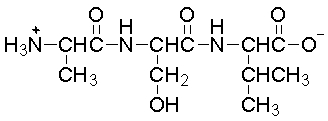 I. Val-Ser-Ala II. Ser-Ala-Val
I. Val-Ser-Ala II. Ser-Ala-Val
III) Ala-Ser-Val
A) All of these represent the same molecule.
B) I and III
C) I only
D) II only
E) III only
 I. Val-Ser-Ala II. Ser-Ala-Val
I. Val-Ser-Ala II. Ser-Ala-ValIII) Ala-Ser-Val
A) All of these represent the same molecule.
B) I and III
C) I only
D) II only
E) III only

Unlock Deck
Unlock for access to all 122 flashcards in this deck.
Unlock Deck
k this deck
43
Hydrolysis of the peptide bonds in peptide below would result in 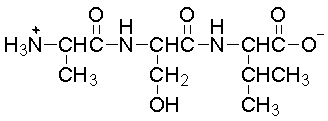
A) no reaction.
B) a single amino acid.
C) two amino acids.
D) three amino acids.
E) four amino acids.

A) no reaction.
B) a single amino acid.
C) two amino acids.
D) three amino acids.
E) four amino acids.

Unlock Deck
Unlock for access to all 122 flashcards in this deck.
Unlock Deck
k this deck
44
In the peptide Ser-Gly-Asp-Ala, the N-terminal amino acid is
A) aspartic acid.
B) alanine.
C) cysteine.
D) serine.
E) glycine.
A) aspartic acid.
B) alanine.
C) cysteine.
D) serine.
E) glycine.

Unlock Deck
Unlock for access to all 122 flashcards in this deck.
Unlock Deck
k this deck
45
When two amino acids react to form a new amide functional group, the reaction is referred to as a(n)
A) hydrolysis.
B) amidation.
C) esterification.
D) hydration.
E) dehydration.
A) hydrolysis.
B) amidation.
C) esterification.
D) hydration.
E) dehydration.

Unlock Deck
Unlock for access to all 122 flashcards in this deck.
Unlock Deck
k this deck
46
Which of the following statements best describes the naming convention for peptides?
A) There is no naming convention.
B) Start from the C-terminus and continue in order to the N-terminus.
C) Start on the left and continue in order to the right.
D) Start from the N-terminus and continue in order to the C-terminus.
E) Start on the right and continue in order to the left.
A) There is no naming convention.
B) Start from the C-terminus and continue in order to the N-terminus.
C) Start on the left and continue in order to the right.
D) Start from the N-terminus and continue in order to the C-terminus.
E) Start on the right and continue in order to the left.

Unlock Deck
Unlock for access to all 122 flashcards in this deck.
Unlock Deck
k this deck
47
The boxed bond in the following peptide is a 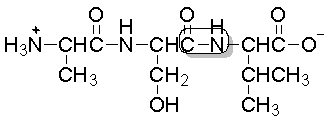
A) peptide bond.
B) ionic bond.
C) nonpolar covalent bond.
D) hydrogen bond.
E) chiral carbon.

A) peptide bond.
B) ionic bond.
C) nonpolar covalent bond.
D) hydrogen bond.
E) chiral carbon.

Unlock Deck
Unlock for access to all 122 flashcards in this deck.
Unlock Deck
k this deck
48
Is the peptide shown below chiral? 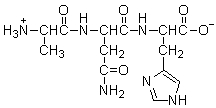
A) No, molecules with multiple centers of chirality are not chiral.
B) Yes, it has centers of chirality.
C) No, it has no centers of chirality.
D) Yes, it has no centers of chirality.
E) It is not possible to determine whether or not the peptide is chiral.

A) No, molecules with multiple centers of chirality are not chiral.
B) Yes, it has centers of chirality.
C) No, it has no centers of chirality.
D) Yes, it has no centers of chirality.
E) It is not possible to determine whether or not the peptide is chiral.

Unlock Deck
Unlock for access to all 122 flashcards in this deck.
Unlock Deck
k this deck
49
How does your body know which proteins to make and in what order to place the amino acids when the proteins are synthesized?
A) The body does not make proteins; they are consumed in the diet.
B) There are special proteins in which this information is encoded.
C) Our DNA acts as a blueprint for proteins.
D) Our brain does this subconsciously.
E) The answer is not known to science.
A) The body does not make proteins; they are consumed in the diet.
B) There are special proteins in which this information is encoded.
C) Our DNA acts as a blueprint for proteins.
D) Our brain does this subconsciously.
E) The answer is not known to science.

Unlock Deck
Unlock for access to all 122 flashcards in this deck.
Unlock Deck
k this deck
50
What is indicated by the arrow pointing to part of the Fischer projection below? 
A) Nothing, this is just two molecules with their bonds crossed.
B) This is a carbon in the side chain of an amino acid.
C) This is the alpha carbon of an amino acid.
D) This is a carbon with a planar geometry.
E) This can be any type of atom.

A) Nothing, this is just two molecules with their bonds crossed.
B) This is a carbon in the side chain of an amino acid.
C) This is the alpha carbon of an amino acid.
D) This is a carbon with a planar geometry.
E) This can be any type of atom.

Unlock Deck
Unlock for access to all 122 flashcards in this deck.
Unlock Deck
k this deck
51
What is indicated by the arrow pointing to part of the Fischer projection below? 
A) the beta carbon
B) the anomeric carbon
C) a center of chirality
D) a secondary amine
E) a peptide bond

A) the beta carbon
B) the anomeric carbon
C) a center of chirality
D) a secondary amine
E) a peptide bond

Unlock Deck
Unlock for access to all 122 flashcards in this deck.
Unlock Deck
k this deck
52
When two amino acids react to form a peptide bond, what new functional group is created?
A) an alcohol
B) an amine
C) an amide
D) an ester
E) a phosphoester
A) an alcohol
B) an amine
C) an amide
D) an ester
E) a phosphoester

Unlock Deck
Unlock for access to all 122 flashcards in this deck.
Unlock Deck
k this deck
53
When several amino acids are connected together, head-to-tail, the resulting molecule is called a(n) __________. When many amino acids are connected together, the molecule is called a(n) ___________.
A) enzyme; polypeptide
B) protein; polypeptide
C) polypeptide; protein
D) polypeptide; enzyme
E) nucleic acid; enzyme
A) enzyme; polypeptide
B) protein; polypeptide
C) polypeptide; protein
D) polypeptide; enzyme
E) nucleic acid; enzyme

Unlock Deck
Unlock for access to all 122 flashcards in this deck.
Unlock Deck
k this deck
54
Is Gly-Ala-His the same tripeptide as His-Ala-Gly?
A) No, they are constitutional isomers.
B) No, they are stereoisomers.
C) Yes, they are conformers.
D) Yes, they are the same molecule, just flipped over.
E) Yes, the written order of amino acids does not make a difference in the peptide.
A) No, they are constitutional isomers.
B) No, they are stereoisomers.
C) Yes, they are conformers.
D) Yes, they are the same molecule, just flipped over.
E) Yes, the written order of amino acids does not make a difference in the peptide.

Unlock Deck
Unlock for access to all 122 flashcards in this deck.
Unlock Deck
k this deck
55
What is the molecular shape of the carbon with the asterisk next to it? 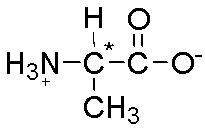
A) linear
B) bent
C) trigonal planar
D) tetrahedral
E) pyramidal

A) linear
B) bent
C) trigonal planar
D) tetrahedral
E) pyramidal

Unlock Deck
Unlock for access to all 122 flashcards in this deck.
Unlock Deck
k this deck
56
The following compound is a(n) 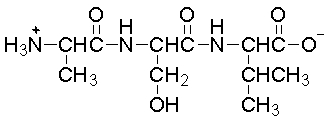
A) amino acid.
B) dipeptide.
C) tripeptide.
D) polypeptide.
E) protein.

A) amino acid.
B) dipeptide.
C) tripeptide.
D) polypeptide.
E) protein.

Unlock Deck
Unlock for access to all 122 flashcards in this deck.
Unlock Deck
k this deck
57
Which of the amino acids in the following structure are at the N-terminus? 
A) all of them
B) I only
C) III only
D) II and III
E) I and III

A) all of them
B) I only
C) III only
D) II and III
E) I and III

Unlock Deck
Unlock for access to all 122 flashcards in this deck.
Unlock Deck
k this deck
58
About how many different proteins are in the human body?
A) one hundred
B) one thousand
C) ten thousand
D) one hundred thousand
E) one million
A) one hundred
B) one thousand
C) ten thousand
D) one hundred thousand
E) one million

Unlock Deck
Unlock for access to all 122 flashcards in this deck.
Unlock Deck
k this deck
59
Which of the following structures is the enantiomer of l-alanine? 
A)a
B)b
C)c
D)d
E)e

A)a
B)b
C)c
D)d
E)e

Unlock Deck
Unlock for access to all 122 flashcards in this deck.
Unlock Deck
k this deck
60
What type of bond is a peptide bond?
A) an ionic bond
B) a nonpolar covalent bond
C) a polar covalent bond
D) a hydrogen bond
E) a salt bridge
A) an ionic bond
B) a nonpolar covalent bond
C) a polar covalent bond
D) a hydrogen bond
E) a salt bridge

Unlock Deck
Unlock for access to all 122 flashcards in this deck.
Unlock Deck
k this deck
61
An example of this type of protein is shown below. 
A) keratin
B) keratin, elastin, and collagen
C) membrane proteins and globular proteins
D) globular proteins
E) membrane proteins

A) keratin
B) keratin, elastin, and collagen
C) membrane proteins and globular proteins
D) globular proteins
E) membrane proteins

Unlock Deck
Unlock for access to all 122 flashcards in this deck.
Unlock Deck
k this deck
62
These proteins are structural in nature.
A) keratin
B) keratin, elastin, and collagen
C) membrane proteins and globular proteins
D) globular proteins
E) membrane proteins
A) keratin
B) keratin, elastin, and collagen
C) membrane proteins and globular proteins
D) globular proteins
E) membrane proteins

Unlock Deck
Unlock for access to all 122 flashcards in this deck.
Unlock Deck
k this deck
63
A protein's native conformation is
A) its shape when it is first made.
B) its shape when it is not bound to a substrate.
C) its three-dimensional shape in which it is biologically active.
D) the shape of the protein without any cofactors.
E) the shape of the protein without any coenzymes.
A) its shape when it is first made.
B) its shape when it is not bound to a substrate.
C) its three-dimensional shape in which it is biologically active.
D) the shape of the protein without any cofactors.
E) the shape of the protein without any coenzymes.

Unlock Deck
Unlock for access to all 122 flashcards in this deck.
Unlock Deck
k this deck
64
Enzymes are typically composed of this type of protein.
A) keratin
B) keratin, elastin, and collagen
C) membrane proteins and globular proteins
D) globular proteins
E) membrane proteins
A) keratin
B) keratin, elastin, and collagen
C) membrane proteins and globular proteins
D) globular proteins
E) membrane proteins

Unlock Deck
Unlock for access to all 122 flashcards in this deck.
Unlock Deck
k this deck
65
Which side chain would most likely be found in the interior of a protein, away from the aqueous environment?
A) -CH2OH
B) -CH2SH
C) -CH2COOH
D) -CH2CONH2
E)
A) -CH2OH
B) -CH2SH
C) -CH2COOH
D) -CH2CONH2
E)


Unlock Deck
Unlock for access to all 122 flashcards in this deck.
Unlock Deck
k this deck
66
Interleukin-4, a polypeptide, is shown below. In which of the following are the secondary structures labeled correctly? 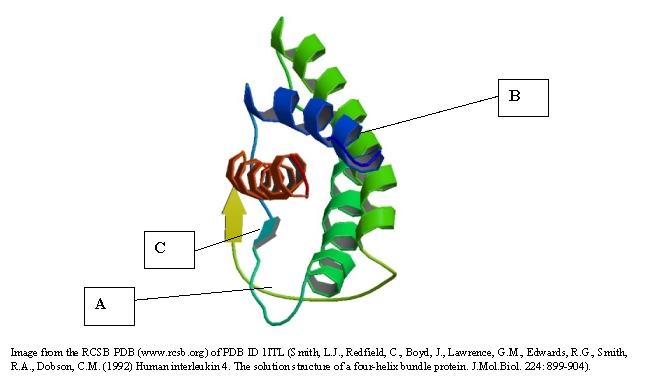
A) A: random folding B: β-pleated sheets C: α-helix
B) A: β-pleated sheets B: random folding C. α-helix
C) A: random folding B. α-helix C: β-pleated sheets
D) A. α-helix B: random folding C: β-pleated sheets
E) A: β-pleated sheets B: α-helix C: random folding

A) A: random folding B: β-pleated sheets C: α-helix
B) A: β-pleated sheets B: random folding C. α-helix
C) A: random folding B. α-helix C: β-pleated sheets
D) A. α-helix B: random folding C: β-pleated sheets
E) A: β-pleated sheets B: α-helix C: random folding

Unlock Deck
Unlock for access to all 122 flashcards in this deck.
Unlock Deck
k this deck
67
What type of secondary structure is in blue in the following protein?

A) an α-helix
B) a parallel β-pleated sheet
C) an antiparallel β-pleated sheet
D) a random coil
E) This illustration does not show secondary structure.

A) an α-helix
B) a parallel β-pleated sheet
C) an antiparallel β-pleated sheet
D) a random coil
E) This illustration does not show secondary structure.

Unlock Deck
Unlock for access to all 122 flashcards in this deck.
Unlock Deck
k this deck
68
Which of the following correctly shows the electrostatic interaction between amino acids that holds an -helix or -pleated sheet together? 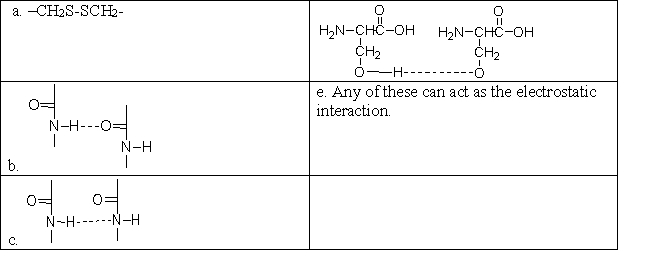
A)a
B)b
C)c
D)d
E)e

A)a
B)b
C)c
D)d
E)e

Unlock Deck
Unlock for access to all 122 flashcards in this deck.
Unlock Deck
k this deck
69
In order to break a disulfide bond, what type of reaction occurs?
A) an oxidation
B) a hydration
C) a dehydration
D) a reduction
E) an esterification
A) an oxidation
B) a hydration
C) a dehydration
D) a reduction
E) an esterification

Unlock Deck
Unlock for access to all 122 flashcards in this deck.
Unlock Deck
k this deck
70
Sometimes, substitutions of one amino acid for another in a protein results in a large change in secondary and tertiary structure. Sometimes, the substitution leads to very little change. The structure of valine is shown below. Which of the choices of amino acids given would probably cause the least amount of perturbation to protein structure if it was substituted for a valine? 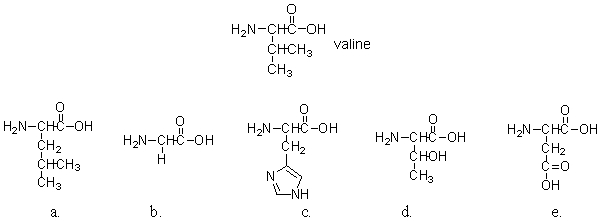
A)a
B)b
C)c
D)d
E)e

A)a
B)b
C)c
D)d
E)e

Unlock Deck
Unlock for access to all 122 flashcards in this deck.
Unlock Deck
k this deck
71
Which of the following interactions holds the -helix and the -pleated sheet into its unique folding pattern?
A) covalent bonding between cysteines (-CH2SH)
B) hydrogen bonding between serines (-CH2OH)
C) hydrogen bonding between nitrogens and oxygens in the amino acid backbone
D) ionic bonding between acidic and basic amino acid side chains
E) hydrophilic interactions
A) covalent bonding between cysteines (-CH2SH)
B) hydrogen bonding between serines (-CH2OH)
C) hydrogen bonding between nitrogens and oxygens in the amino acid backbone
D) ionic bonding between acidic and basic amino acid side chains
E) hydrophilic interactions

Unlock Deck
Unlock for access to all 122 flashcards in this deck.
Unlock Deck
k this deck
72
Which side chain would most likely be involved in hydrogen bonding?
A) -CH2OH
B) -CH2SH
C) -CH2COOH
D) -CH2CONH2
E)
A) -CH2OH
B) -CH2SH
C) -CH2COOH
D) -CH2CONH2
E)


Unlock Deck
Unlock for access to all 122 flashcards in this deck.
Unlock Deck
k this deck
73
Which of the following amino acids can form a disulfide bridge?
A) glycine
B) alanine
C) serine
D) aspartic acid
E) lysine
A) glycine
B) alanine
C) serine
D) aspartic acid
E) lysine

Unlock Deck
Unlock for access to all 122 flashcards in this deck.
Unlock Deck
k this deck
74
Which of the following statements best describes a prosthetic group?
A) They are nonpeptide molecules or ions essential to a protein's structure.
B) They are short peptide chains attached to a larger protein.
C) They are nonfunctional components of a protein.
D) They are the active part of a protein.
E) They are the part of the protein that provides structure.
A) They are nonpeptide molecules or ions essential to a protein's structure.
B) They are short peptide chains attached to a larger protein.
C) They are nonfunctional components of a protein.
D) They are the active part of a protein.
E) They are the part of the protein that provides structure.

Unlock Deck
Unlock for access to all 122 flashcards in this deck.
Unlock Deck
k this deck
75
Which of the following statements about disulfide bridges is FALSE?
A) Disulfide bridges are found in the tertiary structure of a protein.
B) Disulfide bridges can occur between nonadjacent, and even distant, amino acids.
C) Disulfide bridges are covalent bonds.
D) Reducing a disulfide bridge gives two thiols.
E) A disulfide bridge is weaker than a hydrogen bond.
A) Disulfide bridges are found in the tertiary structure of a protein.
B) Disulfide bridges can occur between nonadjacent, and even distant, amino acids.
C) Disulfide bridges are covalent bonds.
D) Reducing a disulfide bridge gives two thiols.
E) A disulfide bridge is weaker than a hydrogen bond.

Unlock Deck
Unlock for access to all 122 flashcards in this deck.
Unlock Deck
k this deck
76
What type of interaction would you expect between the following R groups in the tertiary structure of a protein? 
A) hydrogen bonds
B) hydrophobic interactions
C) peptide bonds
D) disulfide bonds
E) salt bridges

A) hydrogen bonds
B) hydrophobic interactions
C) peptide bonds
D) disulfide bonds
E) salt bridges

Unlock Deck
Unlock for access to all 122 flashcards in this deck.
Unlock Deck
k this deck
77
In some proteins, hydrogen bonding occurs between polar residues and the surrounding aqueous environment, forcing the polar residues to the exterior of the protein. What are the interactions between the polar residues and the aqueous environment called?
A) hydrophilic interactions
B) salt bridges
C) nonpolar interactions
D) hydrophobic interactions
E) dispersion forces
A) hydrophilic interactions
B) salt bridges
C) nonpolar interactions
D) hydrophobic interactions
E) dispersion forces

Unlock Deck
Unlock for access to all 122 flashcards in this deck.
Unlock Deck
k this deck
78
What kinds of interactions are NOT part of tertiary protein structure?
A) hydrophobic interactions
B) peptide bonds
C) hydrophilic interactions
D) salt bridges
E) disulfide bonds
A) hydrophobic interactions
B) peptide bonds
C) hydrophilic interactions
D) salt bridges
E) disulfide bonds

Unlock Deck
Unlock for access to all 122 flashcards in this deck.
Unlock Deck
k this deck
79
Which of the following types of interactions result in proteins folding so that nonpolar residues are on the interior of the protein, protected from water?
A) hydrogen bonds
B) salt bridges
C) disulfide bonds
D) hydrophilic interactions
E) dispersion forces
A) hydrogen bonds
B) salt bridges
C) disulfide bonds
D) hydrophilic interactions
E) dispersion forces

Unlock Deck
Unlock for access to all 122 flashcards in this deck.
Unlock Deck
k this deck
80
Alpha-helices and β-pleated sheets are both examples of
A) primary structure.
B) secondary structure.
C) tertiary structure.
D) quaternary structure.
E) both secondary and tertiary structure.
A) primary structure.
B) secondary structure.
C) tertiary structure.
D) quaternary structure.
E) both secondary and tertiary structure.

Unlock Deck
Unlock for access to all 122 flashcards in this deck.
Unlock Deck
k this deck



